Teaching Knowledge and Skills the HealthSmart Way – Part 3
By Suzanne Schrag | November 14, 2017
Editor/Product Manager, ETR
How do we give students the concepts and skills they need to choose healthy behaviors for a lifetime? As I discussed in Part 1 and Part 2 of this series, that’s the primary goal of HealthSmart, ETR’s comprehensive, K-12 health education program. I’ve been working with the HealthSmart team since its inception.
From the 15 Characteristics of Effective Health Education Curricula identified by the CDC, we know that an effective program “provides functional health knowledge that directly contributes to health-promoting decisions and behaviors.” It also “builds competence and self-efficacy by addressing skills.”
Let’s see some examples of how these two key components of a great health education program play out in Grade 2 of HealthSmart.
Achieving the Healthy Behavior Outcomes (HBOs) defined by CDC—the things students should be able to do by the time they graduate in order to be health literate—drives the instruction throughout all grade levels.
In Part 1 of this series, I described the primary goal of HealthSmart: to impact students’ health behaviors in a positive way. In Part 2, we examined the theoretical foundation of HealthSmart, and the ways it puts what research tells us about effective programs into action.
Functional Health Knowledge: Key Concepts for Preventing Infectious Disease
HealthSmart addresses functional health knowledge to lead to the practice of healthy behaviors. Here’s an example from a Grade 2 lesson under Personal Health & Wellness.
Functional Health Knowledge
Facts and concepts that are essential to making healthy decisions and practicing health-enhancing behaviors.
For example, learning about the circulatory system is interesting, but it isn’t really going to help address the health risk of inadequate physical activity. On the other hand, knowing that activities that make your heart beat faster and your lungs breathe harder help you stay healthy, and then setting a goal to be active for 60 minutes a day, can make a difference.
(Described in more detail in post 2 of this series.)
These are the Healthy Behavior Outcomes (HBOs) that Lesson 5: Preventing Colds and Fighting Germs is intended to address:
- Practice appropriate hygiene habits.
- Practice behaviors that prevent infectious disease.
- Practice behaviors that prevent food-borne illness.
First, students are presented with the functional knowledge that will help them understand the reasons behind a health behavior and motivate behavior change. The teacher shows a colorful image to teach these two key facts about germs: (1) germs can make you sick, and (2) germs can be passed from person to person.
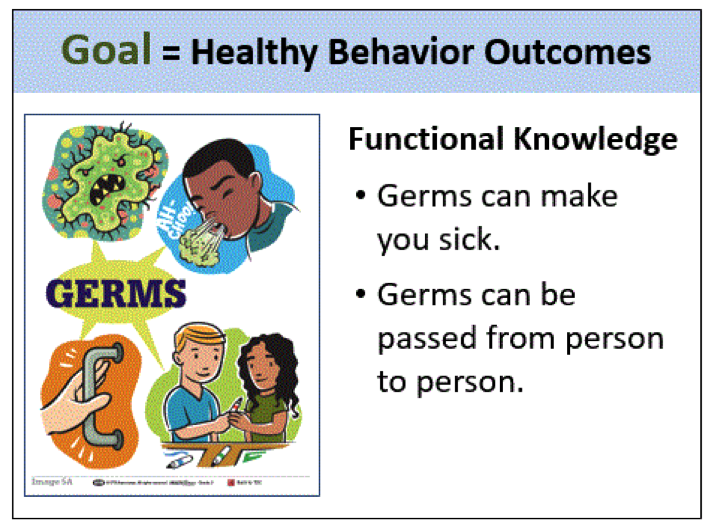
The lesson helps students comprehend key concepts. Using another image as a motivator, they brainstorm and discuss the many different ways germs could be spread in a classroom. Then the educator helps them come up with some simple rules they could follow to help keep germs from spreading.
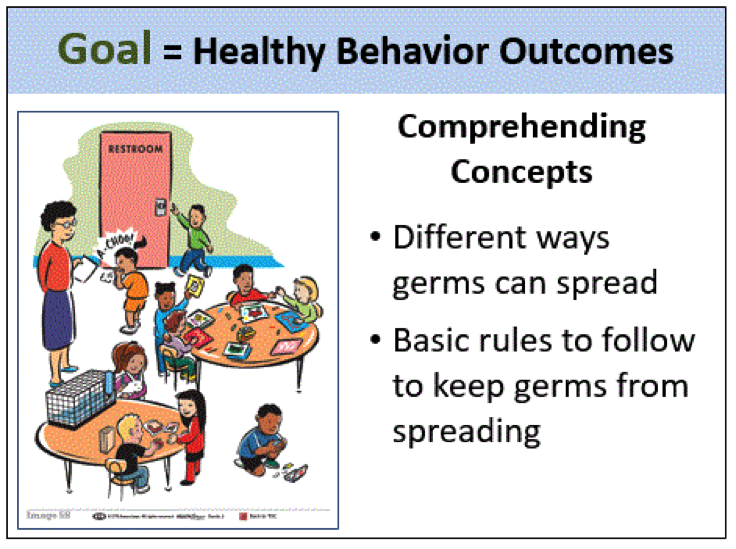
The lesson concludes with a teacher demonstration and then student practice of proper handwashing (a healthy behavior first introduced at Grade K and reinforced at Grades 1, 2 and 3).
Here is where we can really see that distinction between “need to know” (functional knowledge) and “nice to know” (of interest, but not essential to the practice of healthy behavior). Proper handwashing is essential to help prevent infectious disease and food-borne illness—it’s “need to know” for achieving these healthy behavior outcomes. On the other hand, teaching students the distinctions among different types of pathogens, particularly at the second-grade level, does not directly contribute to a healthy behavior outcome. So it’s not covered in this lesson.
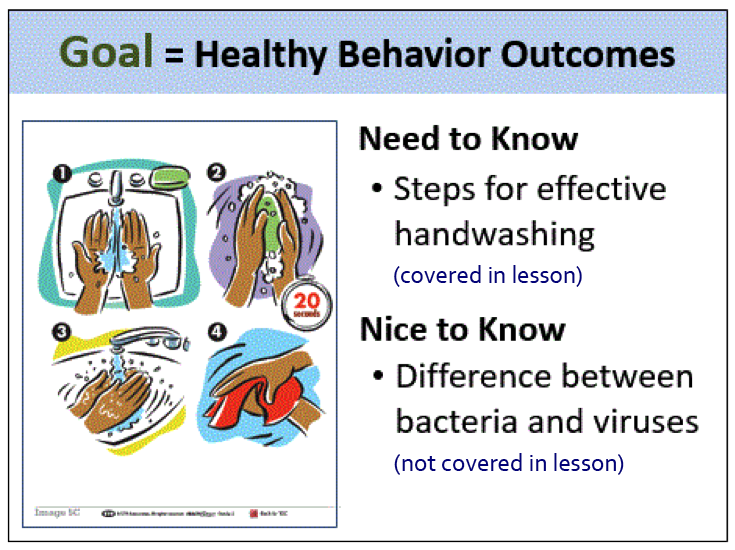
In this Grade 2 lesson, real-world application of the knowledge students gain includes a take-home family sheet that helps families discuss disease prevention at home. The take-home family sheets featured at all grade levels of the program are designed to promote family discussion and support parents, guardians and other caring adults in having discussions of various health topics with their children.
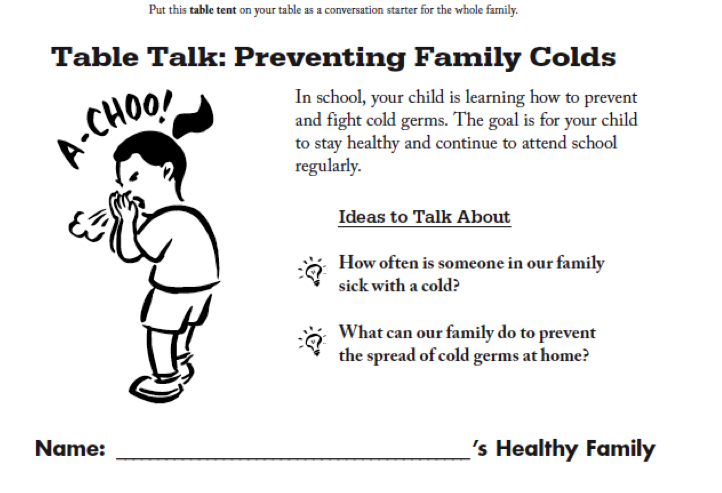
Key Skills for Health Literacy
The National Health Education Standards outline a range of key skills that belong in effective programs.
At each grade level, HealthSmart focuses on the skills that best fit the content area, students’ developmental levels and the types of risks they are likely to be facing at that point in their lives—or in the near future. Here are some examples from the newly revised K–5 HealthSmart.
We’ve already discussed Standard 1: Comprehending Concepts.
Standard 2: Analyzing Influences largely focuses on family and friends at Grades K, 1 and 2, and moves into the wider influences of culture, media and technology at Grades 3, 4 and 5.
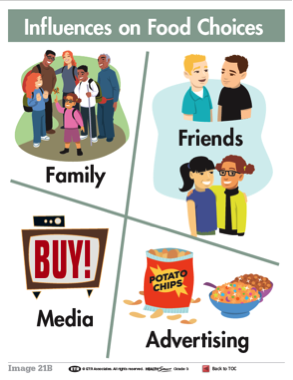
Grade 3—Analyzing Influences (exploring influences on food choices)
Standard 3: Accessing Resources includes seeking help from trusted adults at the lower grade levels and how to evaluate online resources once students reach the upper elementary grades.
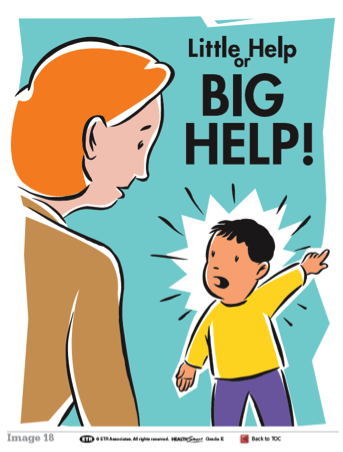
Grade K—Accessing Resources (making the distinction between “big help” and “little help”)
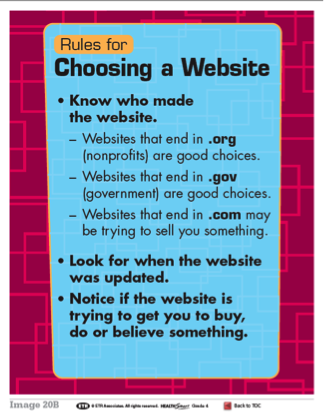
Grade 4—Accessing Resources (evaluating online resources)
Standard 4: Interpersonal Communication covers wide range of different skills, from communicating to build successful relationships, to refusals and resisting pressure, conflict resolution and asking for help.
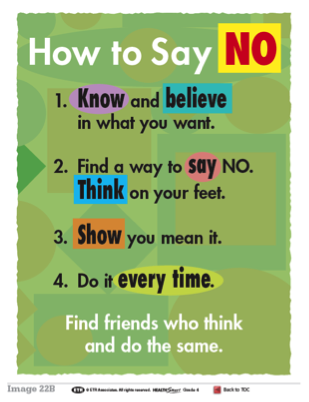
Grade 4—Interpersonal Communication (refusal skills for tobacco and alcohol prevention)
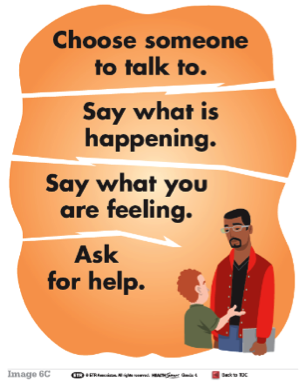
Grade 3—Interpersonal Communication (asking for help)
For Standard 5: Decision Making and Standard 6: Goal Setting, the skill process becomes more detailed as students grow, from either/or choices and making a simple pledge at Grade K, to working through an increasingly detailed series of steps as students advance through the elementary grades.
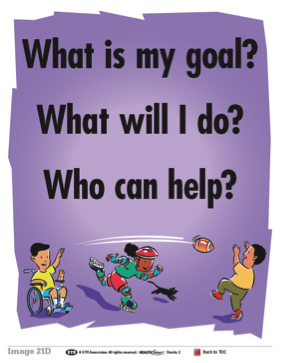
Grade 2—Goal Setting (improving nutrition & physical activity habits)
Standard 7: Practicing Health-Enhancing Behaviors covers behaviors that promote health or help students avoid or reduce risks. Throughout the HealthSmart lessons, students have the opportunity to practice concrete steps that will support them in practicing these behaviors.
Standard 8: Advocacy offers opportunities for review and application. Throughout each grade level, students have many chances to share what they’ve learned with others, with the advocacy process again becoming more sophisticated as we move through the grades.
Skills to Build Competence and Self-Efficacy: A Decision-Making Example
Now let’s take a look at how the newly revised HealthSmart K–5 program builds these skills. This decision-making lesson from Grade 2 reinforces the following HBOs for Safety and Injury Prevention.
- Apply safety rules and procedures to avoid risky behaviors and injury.
- Avoid safety hazards at home and in the community.
- Recognize and avoid dangerous surroundings.
1. Introduce the Skill
The lesson uses ETR’s research-based approach to skill development. First, the educator introduces the skill and helps students relate it to their lives: “We’re going to talk about how you can make safety-smart choices. These are the kinds of choices that will help keep you from getting hurt or taking risks. Sometimes people wait until after they are hurt to think about what they did that was unsafe or risky. But then it is too late to make a difference. Being safety smart means you take the time to think ahead to make safe choices. We’re going to practice that today.”
2. Teach the Skill
Next, the educator presents the sequential and specific steps for the successful performance of the skill. In this example, a simple series of questions is used to help students work through the steps to making a safe decision: “You can use the Safety Smart Questions to help you make smart and safe choices.”

3. Model the Skill
Then the educator models the skill process with several examples. This is a critical part of the skill-development process. In the first example, students see an image and hear a story about a second grader who is in a hurry to get to school and has a choice to make between crossing between parked cars or taking extra time to go to the crosswalk.
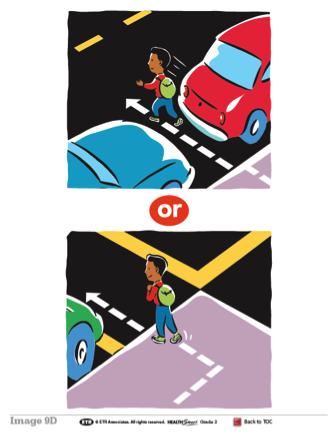
The teacher uses the Safety Smart questions to guide students through the decision-making process:
- Does Angelino have a choice to make?
- What are his choices?
- What could happen with each choice?
- What is the Safety Smart choice?
A second example focuses on a second pedestrian safety situation. In this example, a student is feeling upset about something that happened at school that day. As she gets to the end of the block, the traffic light turns yellow, but the streets are empty.
The educator again uses the Safety Smart questions to help students consider the choices and consequences and choose the safest option. After each example, the educator summarizes the reasons behind the safe choice and helps students consider how being in a hurry or having strong emotions can affect their choices.
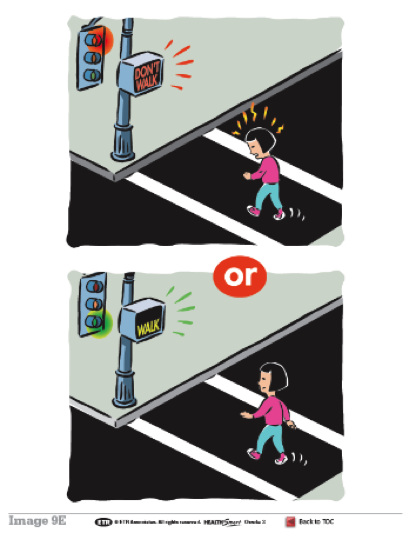
4. Have Students Practice the Skill
Then, students have an opportunity to practice the skill independently. The educator again uses an image to present a third example: “Andrew is walking with some friends who’ve just seen a new movie that he wants to hear about. He is worried about not hearing what is being said. Andrew thinks that if he can put himself in front of the group and skip backwards he will be able to hear everything.”
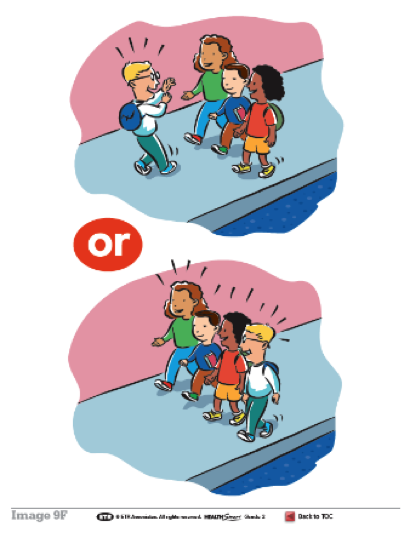
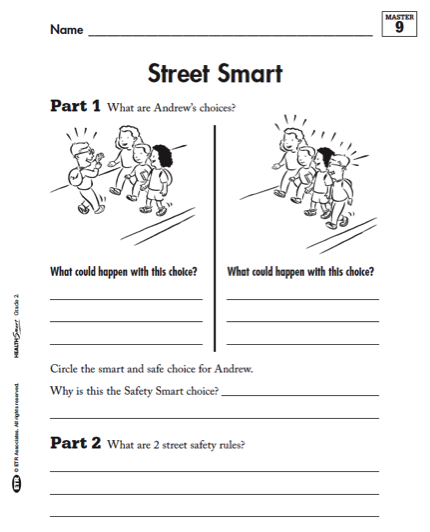
Then students complete an activity sheet to work through the safety smart questions on their own:
- What are Andrew’s choices?
- What could happen with each choice?
- Circle the safe choice.
- Why is this choice Safety Smart?
The last question on the activity sheet helps them synthesize what they’ve been learning by asking them to write two rules they can follow to keep themselves safe as pedestrians.
Check It Out
If you’re intrigued by the HealthSmart approach and would like to learn more about this comprehensive, research-based, standards-aligned K–12 health education program, visit the HealthSmart website. You can also email or call ETR at 1-888-220-9455 to set up review access to the digital edition of the program.
Suzanne Schrag is an Editor and Product Manager at ETR. She is also one of the authors of the new edition of K–5 HealthSmart. She can be reached at schs@etr.org.





